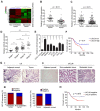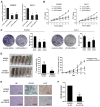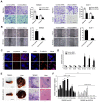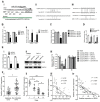Long non-coding RNA UICLM promotes colorectal cancer liver metastasis by acting as a ceRNA for microRNA-215 to regulate ZEB2 expression
- PMID: 29187907
- PMCID: PMC5706103
- DOI: 10.7150/thno.20942
Long non-coding RNA UICLM promotes colorectal cancer liver metastasis by acting as a ceRNA for microRNA-215 to regulate ZEB2 expression
Erratum in
-
Erratum: Long non-coding RNA UICLM promotes colorectal cancer liver metastasis by acting as a ceRNA for microRNA-215 to regulate ZEB2 expression: Erratum.Theranostics. 2025 Jan 9;15(5):2086-2087. doi: 10.7150/thno.108968. eCollection 2025. Theranostics. 2025. PMID: 39897561 Free PMC article.
Abstract
Long non-coding RNAs (lncRNAs) are involved in the pathology of various tumors, including colorectal cancer (CRC). However, the role of lncRNA in CRC liver metastasis remains unclear. Methods: a microarray was performed to identify the differentially expressed lncRNAs between CRC tissues with and without liver metastasis. Survival analysis was evaluated using the Kaplan-Meier method and assessed using the log-rank test. In vitro and in vivo assays were preformed to explore the biological effects of the differentially expressed lncRNA in CRC cells. Results: the lncRNA UICLM (up-regulated in colorectal cancer liver metastasis) was significantly up-regulated in cases of CRC with liver metastasis. Moreover, UICLM expression was higher in CRC tissues than in normal tissues, and UICLM expression was associated with poor patient survival. Knockdown of UICLM inhibited CRC cell proliferation, invasion, epithelial-mesenchymal transition (EMT) and CRC stem cell formation in vitro as well as tumor growth and liver metastasis in vivo. Ectopic expression of UICLM promoted CRC cell proliferation and invasion. Mechanistic investigations revealed that UICLM induced its biological effects by regulating ZEB2, as the oncogenesis facilitated by UICLM was inhibited by ZEB2 depletion. Further study indicated that UICLM acted as a competing endogenous RNA (ceRNA) for miR-215 to regulate ZEB2 expression. Conclusions: taken together, our findings demonstrate how UICLM induces CRC liver metastasis and may offer a novel prognostic marker and therapeutic target for this disease.
Keywords: CRC; liver metastasis.; lncRNA UICLM; long non-coding RNA.
Conflict of interest statement
Competing Interests: The authors have declared that no competing interest exists.
Figures







Similar articles
-
Long noncoding RNA XIST expedites metastasis and modulates epithelial-mesenchymal transition in colorectal cancer.Cell Death Dis. 2017 Aug 24;8(8):e3011. doi: 10.1038/cddis.2017.421. Cell Death Dis. 2017. PMID: 28837144 Free PMC article.
-
Long non-coding RNA ZNFX1-AS1 promotes the tumor progression and metastasis of colorectal cancer by acting as a competing endogenous RNA of miR-144 to regulate EZH2 expression.Cell Death Dis. 2019 Feb 15;10(3):150. doi: 10.1038/s41419-019-1332-8. Cell Death Dis. 2019. PMID: 30770796 Free PMC article.
-
Long noncoding RNA RP11-757G1.5 sponges miR-139-5p and upregulates YAP1 thereby promoting the proliferation and liver, spleen metastasis of colorectal cancer.J Exp Clin Cancer Res. 2020 Oct 6;39(1):207. doi: 10.1186/s13046-020-01717-5. J Exp Clin Cancer Res. 2020. PMID: 33023613 Free PMC article.
-
Long Noncoding RNA (lncRNA)-Mediated Competing Endogenous RNA Networks Provide Novel Potential Biomarkers and Therapeutic Targets for Colorectal Cancer.Int J Mol Sci. 2019 Nov 16;20(22):5758. doi: 10.3390/ijms20225758. Int J Mol Sci. 2019. PMID: 31744051 Free PMC article. Review.
-
H19: An Oncogenic Long Non-coding RNA in Colorectal Cancer.Yale J Biol Med. 2023 Dec 29;96(4):495-509. doi: 10.59249/TDBJ7410. eCollection 2023 Dec. Yale J Biol Med. 2023. PMID: 38161577 Free PMC article. Review.
Cited by
-
lncRNA small nucleolar RNA host gene 12 promotes renal cell carcinoma progression by modulating the miR‑200c‑5p/collagen type XI α1 chain pathway.Mol Med Rep. 2020 Nov;22(5):3677-3686. doi: 10.3892/mmr.2020.11490. Epub 2020 Sep 2. Mol Med Rep. 2020. PMID: 32901847 Free PMC article.
-
MCF2L-AS1/miR-874-3p/STAT3 feedback loop contributes to lung adenocarcinoma cell growth and cisplatin resistance.Heliyon. 2023 Oct 29;9(11):e21342. doi: 10.1016/j.heliyon.2023.e21342. eCollection 2023 Nov. Heliyon. 2023. PMID: 37954302 Free PMC article.
-
Identification and characterization of immune-related lncRNAs and lncRNA-miRNA-mRNA networks of Paralichthys olivaceus involved in Vibrio anguillarum infection.BMC Genomics. 2021 Jun 15;22(1):447. doi: 10.1186/s12864-021-07780-2. BMC Genomics. 2021. PMID: 34130627 Free PMC article.
-
Fusobacterium nucleatum Promotes Metastasis in Colorectal Cancer by Activating Autophagy Signaling via the Upregulation of CARD3 Expression.Theranostics. 2020 Jan 1;10(1):323-339. doi: 10.7150/thno.38870. eCollection 2020. Theranostics. 2020. PMID: 31903123 Free PMC article.
-
ZEB1-AS1/miR-133a-3p/LPAR3/EGFR axis promotes the progression of thyroid cancer by regulating PI3K/AKT/mTOR pathway.Cancer Cell Int. 2020 Mar 29;20:94. doi: 10.1186/s12935-020-1098-1. eCollection 2020. Cancer Cell Int. 2020. PMID: 32231464 Free PMC article.
References
-
- Torre LA, Bray F, Siegel RL, Ferlay J, Lortet-Tieulent J, Jemal A. Global cancer statistics, 2012. CA Cancer J Clin. 2015;65:87–108. - PubMed
-
- Chang GJ, Rodriguez-Bigas MA, Skibber JM, Moyer VA. Lymph node evaluation and survival after curative resection of colon cancer: systematic review. J Natl Cancer Inst. 2007;99:433–41. - PubMed
-
- Esteller M. Non-coding RNAs in human disease. Nat Rev Genet. 2011;12:861–74. - PubMed
Publication types
MeSH terms
Substances
LinkOut - more resources
Full Text Sources
Other Literature Sources
Medical
Molecular Biology Databases
Research Materials

